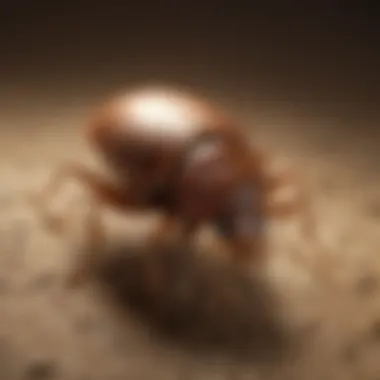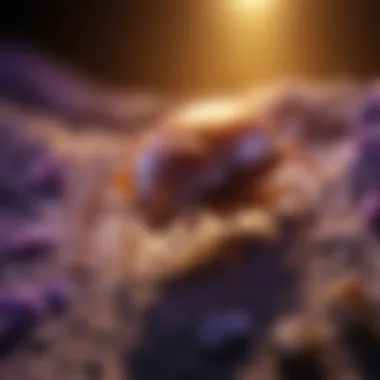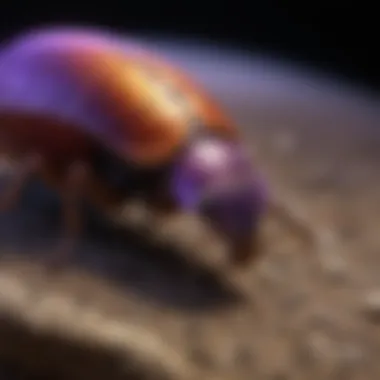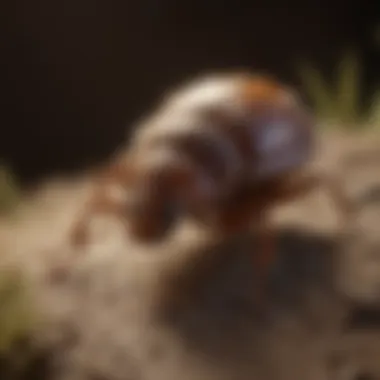Unveiling the Potential of Ultraviolet Light in Bed Bug Eradication


This section aims to delve deep into the fascinating realm of utilizing ultraviolet (UV) light for eradicating pesky bed bugs from our living spaces. The efficacy of UV light in pest control has sparked interest among enthusiasts seeking effective and innovative solutions for dealing with these resilient pests. By grasping the scientific principles behind UV light and its practical applications, individuals can elevate their pest management techniques to combat bed bug infestations effectively.
Introduction
In this section, the spotlight shines on the pivotal role of ultraviolet light in combatting bed bug infestations. As a cutting-edge method gaining traction in pest control, understanding the nuances of ultraviolet light stands paramount. The discourse will delve into how this technology is revolutionizing the eradication of bed bugs, offering a glimpse into its potential implications.
Understanding Bed Bug Infestations
The impact of bed bugs on human health
Examining the implications of bed bug infestations on human health illuminates a significant aspect of the overall pest control landscape. The detrimental effects on human well-being resulting from bed bug bites and the psychological distress caused by infestations form a critical underpinning of the discussion. Spotlighting the implications of these blood-sucking pests serves to underscore the urgency and necessity of effective eradication methods.
Common signs of bed bug infestations
Delving into the common signs of bed bug infestations provides a roadmap for early detection and intervention. Identifying the key indicators such as itchy bites, bloodstains on bedding, and musty odors in infested areas serves as a crucial tool in pest management strategies. Understanding these tell-tale signs equips individuals and pest control professionals with the knowledge to address infestations promptly and effectively.
Current Methods of Bed Bug Control
Chemical treatments
Chemical treatments have long been a cornerstone in the battle against bed bugs, showcasing their potency in extermination efforts. The targeted application of insecticides to eliminate bed bugs at various life stages underscores the effectiveness of chemical interventions. However, concerns over chemical residues, environmental impact, and the development of resistance necessitate a comprehensive exploration of its pros and cons within the context of pest control.
Heat treatments
Harnessing the power of heat as a non-chemical bed bug control method offers a promising alternative. The use of controlled high temperatures to exterminate bed bugs and their eggs highlights the efficiency and eco-friendliness of heat treatments. Investigating the nuances of heat treatments unveils its potential as a standalone or complementary approach in combating bed bug infestations.
Introduction to Ultraviolet Light
Properties of ultraviolet light
Unraveling the unique properties of ultraviolet light elucidates its significance in the pest control domain. The ability of UV light to disrupt bed bug reproduction cycles by targeting their DNA presents a game-changing mechanism in eradication strategies. Delving into the specifics of UV light properties sheds light on its potential as a sustainable and effective tool in pest management.


Applications in various industries
Exploring the diverse applications of ultraviolet light across industries underscores its versatility and adaptability. From sterilization in healthcare settings to disinfection in food processing, the broad spectrum of UV light applications showcases its multi-faceted utility. Understanding the cross-industry relevance of UV light sets the stage for a comprehensive discussion on its efficacy in pest control scenarios.
Scientific Basis
In this article, the scientific basis forms the cornerstone of evaluating the utilization of ultraviolet (UV) light for eradicating bed bugs. Understanding the interactions between UV light and bed bugs is crucial for comprehending its efficacy as a pest control method. By dissecting how UV light influences bed bug behavior and physiology, we can harness its potential to combat infestations effectively. Moreover, exploring the scientific underpinnings enables us to make informed decisions concerning pest management strategies.
How Ultraviolet Light Affects Bed Bugs
Disruption of bed bug reproduction
The disruption of bed bug reproduction stands out as a pivotal aspect in utilizing UV light for pest control. By targeting the reproductive cycle of bed bugs, UV light impedes their ability to proliferate, curtailing infestation rates significantly. This mechanism not only controls current populations but also prevents future outbreaks, making it a strategic choice for efficient bed bug management. However, the challenge lies in ensuring consistent and thorough coverage to maximize the disruption of reproduction across all affected areas.
Impact on bed bug physiology
Understanding the impact of UV light on bed bug physiology sheds light on its effectiveness in eradicating infestations. UV exposure can alter the physiological processes of bed bugs, leading to impaired functions and ultimately their demise. This approach proves advantageous as it specifically targets bed bugs while posing minimal risk to other organisms or the environment. Nonetheless, precise dosing and exposure times are critical to optimize the impact on bed bug physiology and prevent resistance from developing.
Research Studies on Ultraviolet Light
Effectiveness in controlling bed bug populations
Research studies have demonstrated the remarkable effectiveness of UV light in controlling bed bug populations. The targeted nature of UV treatment ensures a high success rate in eliminating bed bugs without leaving behind harmful residues. This method's efficacy extends beyond surface-level control, penetrating hiding spots where bed bugs commonly reside. However, consistent application and monitoring are essential to maintain control levels and prevent resurgence of infestations.
Comparative analysis with traditional methods
Conducting a comparative analysis between UV light and traditional pest control methods offers valuable insights into their respective strengths and limitations. While traditional approaches like chemical treatments may provide immediate results, they often come with associated risks and environmental concerns. UV light, on the other hand, offers a more eco-friendly and targeted solution, minimizing negative impacts on health and surroundings. By juxtaposing these methods, we can discern the superior efficacy and sustainability of UV light in bed bug management.
Application in Pest Control
In delving into the utilization of ultraviolet (UV) light for eradicating bed bugs, the application in pest control stands as a pivotal aspect. This article intricately explores how UV light can revolutionize the field of pest management. With bed bug infestations posing a significant challenge, the introduction of UV devices offers a promising solution. By understanding the specific elements and benefits of incorporating UV light in pest control, enthusiasts in this domain can gain valuable insights towards combating this resilient pest.


Ultraviolet Light Devices
Types of UV devices for bed bug elimination
When considering types of UV devices for bed bug elimination, the focus shifts towards the variety and efficacy of these technological solutions. UV devices come in distinct forms tailored for bed bug eradication, ranging from portable handheld devices to larger units for commercial use. The key characteristic of these devices lies in their ability to emit UV light within the exact wavelength range that targets and disrupts bed bug DNA, leading to their elimination. Their popularity stems from the non-chemical nature of the treatment, offering a safe and eco-friendly alternative in bed bug control efforts.
On the quest for effective bed bug management, the unique feature of UV devices shines through in their precision targeting of pests while minimizing exposure to humans and pets. These devices boast advantages such as non-residual impact, making them a desirable choice for integrated pest management strategies desired by environment-conscious individuals.
Usage considerations and safety measures
Within the realm of UV light devices for pest control, considerations extend beyond efficacy to encompass safety measures crucial for successful application. Understanding the proper use of UV devices is paramount to avoid any potential harm from prolonged exposure to UV radiation. Critical safety measures include wearing protective gear such as UV-blocking glasses and ensuring adequate ventilation in treated areas to mitigate any risks associated with UV exposure.
The key characteristic of adhering to usage considerations and safety measures lies in preventing accidental UV exposure to individuals or pets during the treatment process. This cautious approach ensures that while targeting bed bugs effectively, the well-being of occupants in treated spaces remains uncompromised. The unique feature of these safety protocols underscores the responsible application of UV technology in pest control, emphasizing its advantages in achieving a balance between efficacy and safety.
Integration with Existing Control Strategies
Combination with heat treatments
Integrating UV light devices with existing control strategies such as heat treatments presents a synergistic approach towards combating bed bug infestations. The key characteristic of combining UV light with heat lies in their complementary actions, where UV light targets bed bugs hiding in crevices and undersides of surfaces while heat penetrates deep into fabrics and furniture to eliminate pests. This beneficial strategy enhances the overall effectiveness of treatment methods in reaching bed bugs across varied habitats.
In discussing the unique feature of combining UV light with heat treatments, the advantages become apparent in tackling bed bugs comprehensively. This approach not only increases the likelihood of eradicating all life stages of bed bugs but also reduces the reliance on chemical solutions, promoting sustainable pest management practices.
Supplementing chemical approaches
Supplementing chemical approaches with the integration of UV light devices offers a well-rounded strategy for addressing bed bug infestations. The key characteristic of this supplementation lies in leveraging the advantages of UV light to augment the efficacy of chemical treatments in hard-to-reach areas. By incorporating UV devices alongside chemical solutions, pest control measures become more thorough and effective in targeting bed bugs at all development stages.
Exploring the unique feature of UV light devices as a supplement to chemical approaches underscores the benefits of a multifaceted approach in pest management. The advantages include reducing the reliance on chemical pesticides, minimizing environmental impact, and providing a comprehensive solution for combating bed bug infestations. This holistic integration enhances the overall outcome of pest control efforts, showcasing the potential for an integrated and sustainable approach to bed bug eradication.
Challenges and Considerations
In the realm of pest control, discussing the Challenges and Considerations of utilizing ultraviolet light is paramount. As we navigate the intricacies of eradicating bed bugs, it is crucial to address the obstacles and factors that may impact the efficacy of this innovative approach. By delving into the Challenges and Considerations section, we aim to shed light on the nuances that play a vital role in the successful deployment of ultraviolet light technology. Understanding these challenges allows us to approach bed bug management with a comprehensive strategy that accounts for all pertinent aspects.


Limitations of Ultraviolet Light
Penetration in Hidden Spaces
When considering the Limitations of Ultraviolet Light, the aspect of Penetration in hidden spaces stands out as a key concern. The ability of ultraviolet light to reach secluded areas where bed bugs may thrive is a pivotal factor in its overall effectiveness. Despite its profound utility in visible spaces, the challenge lies in ensuring that the light can penetrate into crevices, cracks, and other inaccessible locations where these pests commonly harbor. Addressing this limitation requires innovative solutions that enhance the reach and coverage of ultraviolet light to eliminate bed bugs comprehensively.
Impact on Non-Target Organisms
Another critical facet of the Limitations of Ultraviolet Light pertains to its Impact on non-target organisms. While the primary goal is to eradicate bed bugs, it is essential to consider the potential consequences on other living beings within the vicinity. Maintaining a delicate balance between targeting pests specifically and safeguarding non-target organisms is a challenging task. Assessing the impact of ultraviolet light on beneficial insects, pets, and humans is imperative to ensure the safe and selective application of this technology, minimizing unintended repercussions.
Safety and Regulatory Aspects
In the domain of pest control utilizing ultraviolet light, the Safety and Regulatory Aspects play a pivotal role in guiding practices and ensuring compliance with industry standards. Discussing the Guidelines for safe UV usage is essential to outline best practices that mitigate risks associated with UV exposure. By understanding these guidelines, pest control professionals can execute treatments safely and effectively, minimizing any potential harm. Moreover, Regulatory compliance in pest control mandates adherence to established protocols and regulations for the responsible application of ultraviolet light technology. Compliance ensures ethical and legal practices while upholding safety standards for both operators and occupants of treated premises.
Future Prospects and Conclusion
As we delve into the future prospects and conclusion of utilizing ultraviolet (UV) light for bed bug control, it becomes evident that ongoing advancements in UV technology hold significant promise. The evolving landscape of pest management is increasingly turning towards more sustainable and effective solutions, with UV light demonstrating considerable potential in this arena. Innovations in UV devices play a pivotal role in enhancing the efficiency and precision of bed bug elimination processes. These technological advancements not only contribute to more targeted pest control strategies but also strive for greater environmental friendliness and reduced reliance on conventional chemical treatments.
Advancements in UV Technology
Innovations in UV devices
The innovations in UV devices represent a groundbreaking shift in the realm of pest control. One key aspect worth highlighting is the enhanced portability and versatility of modern UV devices, allowing for easier maneuvering in various settings and surfaces. Their compact yet powerful design contributes to enhanced efficacy in targeting bed bug infestations. An exceptional characteristic of these devices lies in their integration of advanced sensors and automated mechanisms, ensuring precise and thorough treatment of affected areas. Such features make Innovations in UV devices a favored choice for pest control professionals seeking efficient and environmentally sustainable solutions for bed bug eradication.
Potential for Enhanced Bed Bug Control
The potential for enhanced bed bug control offered by UV technology is substantial. A significant characteristic is the non-toxic nature of UV light, making it a safe alternative to chemical treatments, especially in sensitive environments. Its ability to penetrate hard-to-reach areas and effectively disrupt bed bug reproductive cycles showcases its superiority in combating infestations comprehensively. The unique feature of UV light lies in its non-invasive approach, which minimizes disruptions and downtime during pest control operations. While presenting numerous advantages, it is crucial to consider the requisite expertise and training for optimal utilization of UV technology to achieve maximum benefits in bed bug control initiatives.
Key Takeaways
Summary of Benefits and Challenges
A thorough analysis of the benefits and challenges associated with the use of UV light in bed bug control reveals its multifaceted nature. The primary benefit lies in the non-residual and eco-friendly nature of UV treatment, minimizing environmental impact and health hazards. However, challenges such as limited penetration capabilities in complex infestation settings and potential impact on non-target organisms necessitate careful consideration. Understanding these dynamics is essential for informed decision-making in selecting suitable pest control approaches.
Recommendations for Further Research
In light of the expanding horizons of UV technology in pest management, ongoing research is paramount for uncovering new possibilities and refining existing methodologies. Robust investigations into the long-term effects of UV exposure on different bed bug species, coupled with comprehensive studies on UV device optimization and integration with other control strategies, are fundamental areas for further exploration. Recommendations for further research emphasize the importance of interdisciplinary collaboration and continuous innovation to harness the full potential of UV light for enhanced bed bug control strategies.







